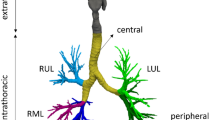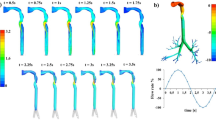Abstract
Computational fluid dynamics (CFD) simulations of airflow and particle deposition in geometries representing the human tracheobronchial tree were conducted. Two geometries were used in this work: (1) based on the Weibel A model, and (2) based on a CT scan of a cadaver lung cast. Flow conditions used included both steady-state inhalation and exhalation conditions as well as time-dependent breathing cycles. Particle trajectories were calculated in each of these models by solving the equations of motion of the particle for the deterministic portion of particle displacement, and adding a stochastic Brownian term at each step. The trapping of particles on the wall surfaces was monitored, and the locations of trapping in each generation were recorded. The results indicate that there are dramatic differences in the predicted deposition between the two models. The intragenerational deposition locations show that in regions where the deposition mechanism is inertial impaction, the predominant deposition seems to be at the airway bifurcations. The results of this study suggest that under most conditions, an idealized model based on the Weibel dimensions is not sufficient to predict deposition, and an accurate model, such as those based on imaging techniques may be required. © 2003 Biomedical Engineering Society.
PAC2003: 8719Uv, 8710+e, 8385Pt
Similar content being viewed by others
REFERENCES
Balashazy, I., T. Heistracher, and W. Hoffman. Air flow and particle deposition patterns in bronchial airway bifurcations: The effect of different CFD models and bifurcation geometries. J. Aerosol Med.9:287–301, 1996.
Balashazy, I., W. Hoffman, and T. Heistracher. Computation of local enhancement factors for the quantification of particle deposition patterns in airway bifurcations. J. Aerosol Sci.30:185–203, 1999.
Balashazy, I., and W. Hoffman. Deposition of aerosols in asymmetric airway bifurcations. J. Aerosol Sci.26:273–292, 1995.
Caro, C.Swirling steady inspiratory flow in models of human bronchial airways (abstract of presentation at BMES annual meeting, RTP 2001). Ann. Biomed. Eng.29:S138, 2001.
Comer, J. K., C. Kleinstreuer, and Z. Zhang. Flow structures and particle deposition patterns in double-bifurcation airway models. Part 1. Air flow fields. J. Fluid Mech.435:25–54, 2001.
Comer, J. K., C. Kleinstreuer, and Z. Zhang. Flow structures and particle deposition patterns in double-bifurcation airway models. Part 2. Aerosol transport and deposition. J. Fluid Mech.435:55–80, 2001.
Darquenne, C.A realistic two-dimensional model of aerosol transport and deposition in the alveolar zone of the human lung. J. Aerosol Sci.32:1161–1174, 2001.
Edwards, D. A.Numerical simulation of air and particle transport in the conducting airways. J. Aerosol Med.9:303–316, 1996.
Edwards, D. A.The macrotransport of aerosol particles in the lung: Aerosol deposition phenomena. J. Aerosol Sci.26:293–317, 1995.
Gaver, D., D. Halpern, W. A. Harvey, M. E. Zimmer, and B. Smith, Ann. Biomed. Eng.29:S140, 2001: abstract of presentation at BMES annual meeting, RTP 2001.
Gresho, P. M., R. L. Lee, and R. L. Sani. On the time-dependent solution of the incompressible Navier–Stokes equations in two and three dimensions. Recent Adv. Numer. Methods Fluids., U.K.1:27–81, 1980.
Heyder, J., J. Gebhart, G. Rudolf, C. F. Schiller, and W. Stahlhofen. Deposition of particles in the human respiratory-tract in the size range 0.005–15 μm. J. Aerosol Sci.17:811–825, 1986.
Li, A., and G. Ahnadi. Dispersion and deposition of spherical particles from point sources in a turbulent channel flow. Aerosol Sci. Technol.16:209–226, 1992.
Li, W. I., M. Perzl, J. Heyder, R. Langer, J. D. Brain, K. H. Englemeier, R. W. Niven, and D. A. Edwards. Aerodynamics and aerosol particle deaggregation phenomena in model oral-pharyngeal cavities. J. Aerosol Sci.27:1269–1286, 1996.
Martonen, T. B., and I. M. Katz. Deposition patterns of polydisperse aerosols within human lungs. J. Aerosol Med.6:251–274, 1993.
Martonen, T. B., C. J. Musante, R. A. Segal, J. D. Schroeter, D. Hwang, M. A. Dolovich, R. Burton, M. Spencer, and J. S. Fleming. Proceedings of the Consensus conference on aerosols and delivery devices, Bermuda, 1999. Respir. Care45:712–736, 2000.
Martonen, T. B., Y. Yang, and Z. Q. Xue. Influences of cartilaginous rings on tracheobronchial fluid dynamics. Inhalation Toxicol.6:185–203, 1994.
Maxey, M. R., and J. J. Riley. Equation of motion for a small rigid sphere in a nonuniform flow. Phys. Fluids26:883–889, 1983.
Morsi, S. A., and A. J. Alexander. An investigation of particle trajectories in two-phase flow systems. J. Fluid Mech.55:193–208, 1972.
Nowak, N. Chemical Engineering M.S. thesis, Cleveland State University, 2003.
Ounis, H., G. Ahmadi, and J. B. McLaughlin. Brownian diffusion of submicrometer particles in the viscous sublayer. J. Colloid Interface Sci.143:266–277, 1991.
Sarangapani, R., and A. Wexler. Modeling aerosol bolus dispersion in human airways. J. Aerosol Sci.30:1345–1362, 1999.
Sauret, V., K. A. Goatman, J. S. Fleming, and A. G. Bailey. Semiautomated tabulation of the 3D topology and morphology of branching networks using CT: Application to the airway tree. Phys. Med. Biol.44:1625–1638, 1999.
Snyder, B., D. R. Dantzker, and M. I. Jaeger. Flow partitioning in symmetric cascades of branches. J. Appl. Physiol.: Respir., Environ. Exercise Physiol.51:598–606, 1981.
Stapleton, K. W., E. Guentsch, M. K. Hoskinson, and W. H. Finlay. On the suitability of k-_ turbulence modeling for aerosol deposition in the mouth and throat: A comparison with experiment. J. Aerosol Sci.31:739–749, 2000.
Tawhai, M., A. A. Pullan, and P. J. Hunter. Generation of an anatomically based three-dimensional model of the conducting airways. Ann. Biomed. Eng.28:793–802, 2000.
Tippe, A., and A. Tsuda. Recirculating flow in an expanding alveolar model: Experimental evidence of flow-induced mixing of aerosols in the pulmonary acinus. J. Aerosol Sci.31:979–986, 2000.
Weibel, E. R. Morphometry of the Human Lung. New York: Academic, 1963.
Zhang, Z., C. Kleinstreuer, and C. S. Kim. Cyclic micron-size particle inhalation and deposition in a triple bifurcation lung airway model. J. Aerosol Sci.33:257–281, 2002.
Zhang, Z., and C. Kleinstreuer. Effect of particle inlet distributions on deposition in a triple bifurcation lung airway model. J. Aerosol Med.14:13–29, 2001.
Zhang, Z., and C. Kleinstreuer. Transient airflow structures and particle transport in a sequentially branching lung airway model. Phys. Fluids14:862–880, 2002.
Zhao, Y., and B. B. Lieber. Steady inspiratory flow in a model symmetrical bifurcation. J. Biomech. Eng.116:488–496, 1994.
Author information
Authors and Affiliations
Rights and permissions
About this article
Cite this article
Nowak, N., Kakade, P.P. & Annapragada, A.V. Computational Fluid Dynamics Simulation of Airflow and Aerosol Deposition in Human Lungs. Annals of Biomedical Engineering 31, 374–390 (2003). https://doi.org/10.1114/1.1560632
Issue Date:
DOI: https://doi.org/10.1114/1.1560632




